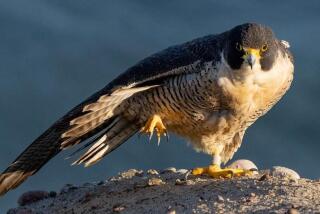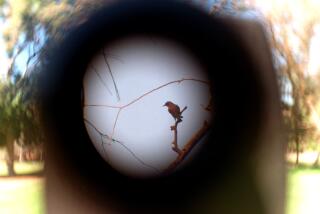Missing: Nearly 3 billion birds that used to live in North America
- Share via
North America has lost nearly 3 billion birds since 1970, according to a new analysis of bird survey and radar data from across the continent.
The sharp decline, described in a study published Thursday in the journal Science, is not just bad for birds. It also bodes ill for the ecosystems those birds inhabit, and points to a need for action to halt and perhaps reverse the drop, scientists said.
“Three billion was a pretty astounding number for us,” said lead author Kenneth Rosenberg, a conservation scientist at Cornell University and the American Bird Conservancy.
Many animals are threatened with extinction because of human activity, but that’s not the only way we do harm. The loss of abundance spells trouble too because it can have profound consequences for the ecosystems they inhabit.
Conservationists studying North American birds had known that at least some species were declining, but they didn’t know what the net loss, or gain, for all birds might be.
“Previously we didn’t have good estimates of population size,” Rosenberg said. “We knew the trends, but we didn’t really know how many birds of each kind were out there.”
To find out, he and his colleagues analyzed more than a dozen bird survey data sets that covered 529 bird species across a host of ecosystems in the U.S. and Canada. These data sets, such as the North American Breeding Bird Survey, rely on citizen scientists who fan out along North American roadsides every year to conduct their counts. The records go back decades.
The researchers were also able to track feathered fliers with a network of 143 weather-radar sites, which often catch migrating birds on their nighttime routes.
The data added up to a grim conclusion: Over nearly half a century, bird populations in North America experienced a steep decline. There are 2.9 billion fewer birds today than there were in 1970 — a reduction of 29%.
Steven Beissinger, a conservation biologist at UC Berkeley, called the results and their implications “dizzying.”
“I was pretty surprised,” said Beissinger, who was not involved in the study. “We don’t usually think in billions of birds.”
Of those lost birds, 90% came from just 12 bird families that include common and widespread species such as sparrows, swallows, warblers and finches.
Declines in the abundance of common species may not seem as dramatic as the endangerment of rare ones, but it is a very serious form of ecosystem erosion, the scientists said.
That’s because abundant species often play important roles in their biomes, whether they control pests, pollinate flowers, disperse seeds, provide food for other animals and even contribute to the natural beauty of an area that draws tourists who support local economies.
“When you’re losing abundance, you’re losing the fabric of the food chains, the fabric of the ecosystems — more perhaps than losing one rare species,” Rosenberg said.
It’s hard to say what ecosystem services have been lost or degraded because of the loss of birds over the last half-century, Beissinger said. For example, if there were more birds around to eat bugs, farmers might be using less pesticide.
Other formerly common species have fallen from mere loss of abundance to elimination.
Rosenberg pointed to the example of the passenger pigeon. Once it was probably the most abundant bird on the planet, but it was hunted into extinction by 1914. He added that the trend line of passenger pigeons’ losses looks similar to the trend seen in the new study, according to work by one of his coauthors, Jessica Stanton of the U.S. Geological Survey.
“Nobody ever thought the passenger pigeon would go extinct — and it did in a relatively short period,” Rosenberg said. “We’re not saying these other birds are on their way to extinction, but it certainly should give us pause.”
Across ecosystems, grassland birds — a group that includes sparrows and meadowlarks — were hit the hardest, the researchers said. Since 1970, their numbers have fallen by more than 720 million, representing 53% of the initial population.
Taken together, more than 1 billion birds have been lost from all forest biomes. Shorebirds, long threatened by the draining of coastal wetlands and urbanization, saw declines of more than 37%. Even the 10 nonnative species counted in the paper experienced a population loss of 63%.
The researchers did not weigh in on specific causes for these declines. But Rosenberg said other work has pointed to habitat loss due to urbanization, pollution, pesticides, and the intensification and expansion of agriculture as likely culprits.
There were a few success stories in the data that could offer a road map for aiding other bird populations, Rosenberg said. Wetland birds, such as ducks and geese, have increased, primarily because of conservation efforts that protected wetland habitats over the last few decades. (Much of that conservation was driven by hunters, who wanted to maintain healthy populations, he added.)
And raptors such as bald eagles, ospreys and peregrine falcons have also improved since the 1970s, when their numbers had been decimated by the use of the pesticide DDT. It was banned for agricultural use in 1972, and laws that protected the birds of prey allowed them to recover.
“It’s yet another example of resilience in the bird population itself if we can remove the threats and give them a chance,” Rosenberg said.
Such policies and protections need to be put in place for other birds in other habitats, said Hillary Young, a conservation biologist at UC Santa Barbara.
“It’s kind of a glimmer of hope because it shows that when you do put in policies to protect these species, they do show long-term trends of recovery,” Young said.
But it’s not just a few kinds of birds that are suffering, she added: “We’re seeing really across-the-board suffering.” The breadth of that suffering shows that humans will need to do more to reduce their environmental footprint.
“We’re going to have to protect everything better if we want to see recovery,” she said.
There are things people can do to help halt the decline, Rosenberg said. For example, keeping cats indoors, choosing products (such as shade-grown coffee) that don’t profit off the destruction of avian habitat, and planting more bird-friendly native shrubs and trees are small steps that can make a difference.
The next step, Beissinger said, will be to figure out which factors are having the biggest impact on bird numbers. “It’s going to be important to try and understand what’s causing this,” he said.
Rosenberg, who has been an avid bird-watcher since the age of 3, said he is choosing to view the new numbers as an opportunity for action.
“It’s time for us to raise our voices and act and change that way we behave and then ultimately try to enact changes in society and in policy,” he said. “That’s the way I’m thinking of it.”







